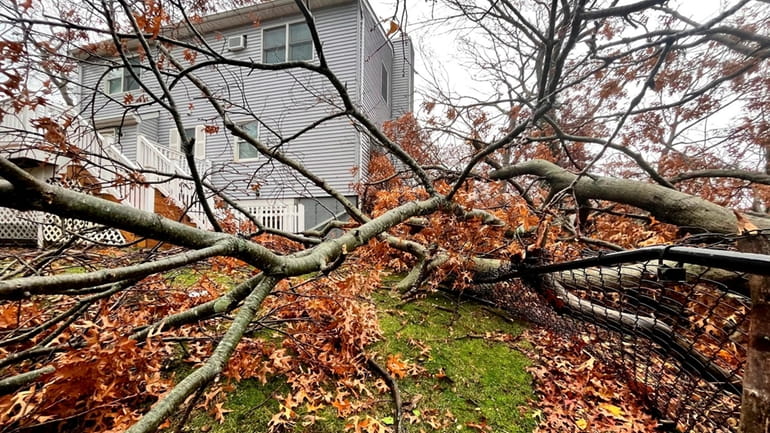Long Island home insurance rates expected to increase 10% or more this year, brokers say

Never mind the recent earthquake. Long Islanders may be trembling when they renew their homeowners’ insurance premiums this year.
A national report by comparison shopping site Insurify projected home insurance prices will increase by 6% this year in the U.S.
Local brokers say Long Island homeowners could see even larger increases. Robyn Sutnick, an insurance broker at Denis A. Miller Insurance Agency in Long Beach, said she wishes she could tell her clients they would only see a 6% increase. She estimated local homeowners could face between a 15% to 25% hike.
“We're seeing crazy increases, especially these past six months,” Sutnick said. “I've been in this business 30 years, and this is probably the tightest market I've seen.”
Homeowners who want to switch to find a better rate also have fewer options, she said.
“You go to certain areas, especially like Long Beach, a coastal area, and there may be two or three admitted companies writing in the area as opposed to 10 that we had three years ago,” she said. Inflation in building costs has been a major driver of increases.
David Levine, owner of Newbrook Insurance Agency in Port Jefferson Station, said he’s telling clients to expect at least a 10% higher premium, while some are seeing increases up to 30%.
“When possible we will move them to a new company, but it’s not one or two companies that are taking the rate increases, it’s the whole industry,” Levine said.
Big losses have made insurers more careful about the risks they take. The property and casualty insurance industry reported its largest underwriting loss in a decade last year, at $38 billion, because of weather-related losses, inflation and higher reinsurance costs, according to credit rating agency A.M. Best. Insurers pay for reinsurance to protect themselves from catastrophic events, such as hurricanes and wildfires.
Underwriting losses occur when premiums don't cover insurers' claims and expenses. The industry was still profitable because insurers earned more than $70 billion last year in investment income, according to A.M. Best.
Insurify projects the average U.S. home insurance premium will rise 6% to $2,522, with disaster-prone Florida projected to see an average premium of $11,759.
The average in New York State is projected to increase 6% as well to $2,404, but Chase Gardner, data insights manager at Insurify, noted that lower-risk areas in upstate New York bring down that average.
Gardner said Long Island, with its risk of coastal storms, has higher-than-average premiums. He compared Patchogue, where Insurify estimated a premium of nearly $2,800 at the end of 2023 to Ithaca, where the same policy would cost about $1,200.
Insurify generated those insurance quotes based on $300,000 in dwelling coverage with a $1,000 deductible. Local brokers said that level of coverage would be insufficient for many Long Island homes.
“Looking out on Long Island, rates there are going to be some of the highest in the state and above the national average,” said Chase Gardner, data insights manager at Insurify. “A lot of that has to do with the weather risk in the area, with severe weather events becoming more frequent and severe under climate change.”
A common misconception is that surging home prices drive higher insurance premiums. It’s actually the cost to rebuild a home that affects premiums, Gardner said.
“Building materials play a much larger role than home values,” Gardner said.
Gardner added that areas such as Long Island where the housing stock is older tend to be more expensive to insure.
The cost of construction materials was 20% higher in February than in the months before the pandemic disrupted the U.S. economy in 2020, according to an analysis from Yield Pro, which tracks the multifamily housing market.
“The cost to rebuild or repair or replace any type of property today is just much more expensive than it was just a few years ago,” said James Sutton, a broker and owner of the James F. Sutton Agency in East Islip.
Sutton said he expects clients to see increases from 10% to 20% this year. He said the insurance market tends to operate in cycles, in which premiums rise to recoup losses but eventually insurers lower prices to attract more policyholders
“We’re still in the midst of what’s happened over the last few years,” he said, referring to the surge in inflation after the pandemic. “It’s probably going to take another year or two for all the issues to be worked out of the system.”
But he cautioned premiums are not likely to return to where they were before the pandemic. “We will not go back to where the rates were four years ago because costs are staying where they are,” he said.
As for earthquakes, Sutnick recommends Long Islanders check their policies if they're worried about future risk.
“It's an exclusion on most policies, but you can always add it back on,” she said.
Never mind the recent earthquake. Long Islanders may be trembling when they renew their homeowners’ insurance premiums this year.
A national report by comparison shopping site Insurify projected home insurance prices will increase by 6% this year in the U.S.
Local brokers say Long Island homeowners could see even larger increases. Robyn Sutnick, an insurance broker at Denis A. Miller Insurance Agency in Long Beach, said she wishes she could tell her clients they would only see a 6% increase. She estimated local homeowners could face between a 15% to 25% hike.
“We're seeing crazy increases, especially these past six months,” Sutnick said. “I've been in this business 30 years, and this is probably the tightest market I've seen.”
Tips for savings
- Bundle home and auto insurance policies.
- Check with your insurer about discounts for loyalty or lengthy periods without claims.
- Notify your insurance agent if you've made home improvements that reduce your home's risk, such as replacing your roof or installing a central-station alarm system.
Homeowners who want to switch to find a better rate also have fewer options, she said.
“You go to certain areas, especially like Long Beach, a coastal area, and there may be two or three admitted companies writing in the area as opposed to 10 that we had three years ago,” she said. Inflation in building costs has been a major driver of increases.
David Levine, owner of Newbrook Insurance Agency in Port Jefferson Station, said he’s telling clients to expect at least a 10% higher premium, while some are seeing increases up to 30%.
“When possible we will move them to a new company, but it’s not one or two companies that are taking the rate increases, it’s the whole industry,” Levine said.
Big losses have made insurers more careful about the risks they take. The property and casualty insurance industry reported its largest underwriting loss in a decade last year, at $38 billion, because of weather-related losses, inflation and higher reinsurance costs, according to credit rating agency A.M. Best. Insurers pay for reinsurance to protect themselves from catastrophic events, such as hurricanes and wildfires.
Underwriting losses occur when premiums don't cover insurers' claims and expenses. The industry was still profitable because insurers earned more than $70 billion last year in investment income, according to A.M. Best.
Insurify projects the average U.S. home insurance premium will rise 6% to $2,522, with disaster-prone Florida projected to see an average premium of $11,759.
The average in New York State is projected to increase 6% as well to $2,404, but Chase Gardner, data insights manager at Insurify, noted that lower-risk areas in upstate New York bring down that average.
Gardner said Long Island, with its risk of coastal storms, has higher-than-average premiums. He compared Patchogue, where Insurify estimated a premium of nearly $2,800 at the end of 2023 to Ithaca, where the same policy would cost about $1,200.
Insurify generated those insurance quotes based on $300,000 in dwelling coverage with a $1,000 deductible. Local brokers said that level of coverage would be insufficient for many Long Island homes.
“Looking out on Long Island, rates there are going to be some of the highest in the state and above the national average,” said Chase Gardner, data insights manager at Insurify. “A lot of that has to do with the weather risk in the area, with severe weather events becoming more frequent and severe under climate change.”
Rebuilding costs spike
A common misconception is that surging home prices drive higher insurance premiums. It’s actually the cost to rebuild a home that affects premiums, Gardner said.
“Building materials play a much larger role than home values,” Gardner said.
Gardner added that areas such as Long Island where the housing stock is older tend to be more expensive to insure.
The cost of construction materials was 20% higher in February than in the months before the pandemic disrupted the U.S. economy in 2020, according to an analysis from Yield Pro, which tracks the multifamily housing market.
“The cost to rebuild or repair or replace any type of property today is just much more expensive than it was just a few years ago,” said James Sutton, a broker and owner of the James F. Sutton Agency in East Islip.
Sutton said he expects clients to see increases from 10% to 20% this year. He said the insurance market tends to operate in cycles, in which premiums rise to recoup losses but eventually insurers lower prices to attract more policyholders
“We’re still in the midst of what’s happened over the last few years,” he said, referring to the surge in inflation after the pandemic. “It’s probably going to take another year or two for all the issues to be worked out of the system.”
But he cautioned premiums are not likely to return to where they were before the pandemic. “We will not go back to where the rates were four years ago because costs are staying where they are,” he said.
As for earthquakes, Sutnick recommends Long Islanders check their policies if they're worried about future risk.
“It's an exclusion on most policies, but you can always add it back on,” she said.
Two body parts suspects in court ... Teen chicken keeper ... Rangers advance ... Penn upgrades
Two body parts suspects in court ... Teen chicken keeper ... Rangers advance ... Penn upgrades

